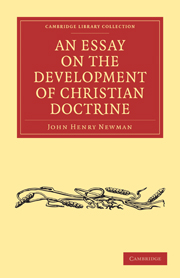Book contents
- Frontmatter
- ADVERTISEMENT
- Contents
- INTRODUCTION
- CHAPTER I ON THE DEVELOPMENT OF IDEAS
- CHAPTER II ON THE DEVELOPMENT OF CHRISTIAN IDEAS, ANTECEDENTLY CONSIDERED
- CHAPTER 3 ON THE NATURE OF THE ARGUMENT IN BEHALF OF THE EXISTING DEVELOPMENTS OF CHRISTIANITY
- CHAPTER IV ILLUSTRATIONS OF THE ARGUMENT IN BEHALF OF THE EXISTING DEVELOPMENTS OF CHRISTIANITY
- CHAPTER V ILLUSTRATIONS CONTINUED
- CHAPTER VI ILLUSTRATIONS CONTINUED
- CHAPTER VII ILLUSTRATIONS CONTINUED
- CHAPTER VIII ILLUSTRATIONS CONCLUDED
CHAPTER V - ILLUSTRATIONS CONTINUED
Published online by Cambridge University Press: 16 May 2011
- Frontmatter
- ADVERTISEMENT
- Contents
- INTRODUCTION
- CHAPTER I ON THE DEVELOPMENT OF IDEAS
- CHAPTER II ON THE DEVELOPMENT OF CHRISTIAN IDEAS, ANTECEDENTLY CONSIDERED
- CHAPTER 3 ON THE NATURE OF THE ARGUMENT IN BEHALF OF THE EXISTING DEVELOPMENTS OF CHRISTIANITY
- CHAPTER IV ILLUSTRATIONS OF THE ARGUMENT IN BEHALF OF THE EXISTING DEVELOPMENTS OF CHRISTIANITY
- CHAPTER V ILLUSTRATIONS CONTINUED
- CHAPTER VI ILLUSTRATIONS CONTINUED
- CHAPTER VII ILLUSTRATIONS CONTINUED
- CHAPTER VIII ILLUSTRATIONS CONCLUDED
Summary
APPLICATION OF THE FIRST TEST CONTINUED.
THE CHURCH OF THE FIFTH AND SIXTH CENTURIES.
The patronage extended by the first Christian Emperors to Arianism, its adoption by the barbarians who succeeded to their power, the subsequent expulsion of all heresy beyond the limits of the Empire, and then again the Monophysite tendencies of Egypt and part of Syria, changed in some measure the aspect of the Church, and claim our further attention. It was still a body in possession, or approximating to the possession, of the orbis terrarum; but it did not altogether lie among the sects, as we have been surveying it in the earlier periods, rather it lay between or over against schisms. That same vast Association, which, and which only, had existed from the first, which had been identified by all parties with Christianity, which had been ever called Catholic by people and by laws, took a different shape; collected itself in far greater strength on some points of her extended territory than on others; possessed whole kingdoms with scarcely a rival; lost others partially or wholly, temporarily or for good; was stemmed in its course here or there by external obstacles; and was confronted by heresy, in a substantive shape and in mass, from foreign lands, and with the support of the temporal power. Thus, not to mention the Axianism of the Eastern Empire in the fourth century, the whole of the West was possessed by the same heresy in the fifth; and nearly the whole of Asia, east of the Euphrates, as far as it was Christian, by the Nestorians, in the centuries which followed; while the Monophysites had almost the possession of Egypt, and at times of the whole Eastern Church.
- Type
- Chapter
- Information
- An Essay on the Development of Christian Doctrine , pp. 270 - 317Publisher: Cambridge University PressPrint publication year: 2010First published in: 1845



